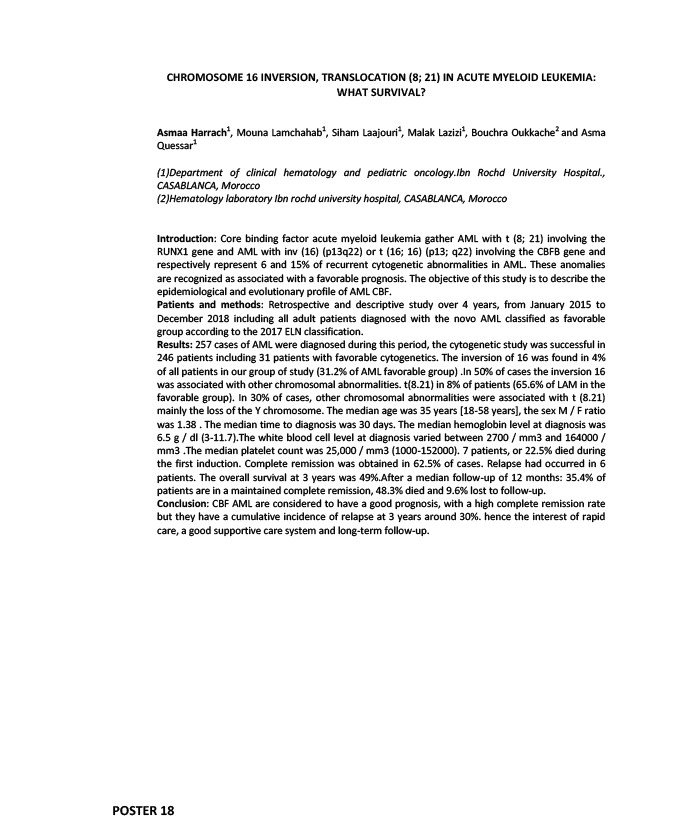
CHROMOSOME 16 INVERSION, TRANSLOCATION (8; 21) IN ACUTE MYELOID LEUKEMIA:
POSTER 18
WHAT SURVIVAL?
Asmaa Harrach1, Mouna Lamchahab1, Siham Laajouri1, Malak Lazizi1, Bouchra Oukkache2 and Asma
Quessar1
(1)Department of clinical hematology and pediatric oncology.Ibn Rochd University Hospital.,
CASABLANCA, Morocco
(2)Hematology laboratory Ibn rochd university hospital, CASABLANCA, Morocco
Introduction: Core binding factor acute myeloid leukemia gather AML with t (8; 21) involving the
RUNX1 gene and AML with inv (16) (p13q22) or t (16; 16) (p13; q22) involving the CBFB gene and
respectively represent 6 and 15% of recurrent cytogenetic abnormalities in AML. These anomalies
are recognized as associated with a favorable prognosis. The objective of this study is to describe the
epidemiological and evolutionary profile of AML CBF.
Patients and methods: Retrospective and descriptive study over 4 years, from January 2015 to
December 2018 including all adult patients diagnosed with the novo AML classified as favorable
group according to the 2017 ELN classification.
Results: 257 cases of AML were diagnosed during this period, the cytogenetic study was successful in
246 patients including 31 patients with favorable cytogenetics. The inversion of 16 was found in 4%
of all patients in our group of study (31.2% of AML favorable group) .In 50% of cases the inversion 16
was associated with other chromosomal abnormalities. t(8.21) in 8% of patients (65.6% of LAM in the
favorable group). In 30% of cases, other chromosomal abnormalities were associated with t (8.21)
mainly the loss of the Y chromosome. The median age was 35 years 18-58 years, the sex M / F ratio
was 1.38 . The median time to diagnosis was 30 days. The median hemoglobin level at diagnosis was
6.5 g / dl (3-11.7).The white blood cell level at diagnosis varied between 2700 / mm3 and 164000 /
mm3 .The median platelet count was 25,000 / mm3 (1000-152000). 7 patients, or 22.5% died during
the first induction. Complete remission was obtained in 62.5% of cases. Relapse had occurred in 6
patients. The overall survival at 3 years was 49%.After a median follow-up of 12 months: 35.4% of
patients are in a maintained complete remission, 48.3% died and 9.6% lost to follow-up.
Conclusion: CBF AML are considered to have a good prognosis, with a high complete remission rate
but they have a cumulative incidence of relapse at 3 years around 30%. hence the interest of rapid
care, a good supportive care system and long-term follow-up.